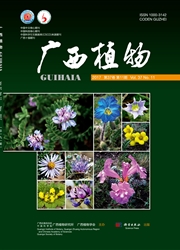

 中文摘要:
中文摘要:
植物血红蛋白(Hemoglobin)是一类由珠蛋白(Globin)和血红素(Ferroheme)组成的结合蛋白,在植物中广泛分布,迄今已在苔藓植物、裸子植物和被子植物中克隆到血红蛋白基因序列,但在蕨类植物中相关研究还未见报道。该研究采用热不对称交错PCR(TAIL-PCR)方法克隆了水蕨血红蛋白基因的全长序列。该基因的序列总长为949 bp,包含4个外显子和3个内含子,编码189个氨基酸。预测的蛋白质(命名为CtHb)的分子量为21.14 kDa,等电点(pI)为7.81。三维结构模拟表明CtHb具有植物血红蛋白典型的三级结构:即含有A、B、C、E、F、G和H螺旋,形成了3-on-3的"三明治"结构。和水稻血红蛋白的三级结构相比,CtHb的大部分结构(包括具有远端和近端组氨酸定位的E螺旋和F螺旋的位置等)同水稻的结构极为相似。两者的不同之处主要表现在:(1)CtHb含有较长的N-端区域;(2)两者CD-loop的折叠方式不同;(3)两者螺旋B和螺旋C的连接方式不同,CtHb是通过卷曲连接的,而水稻中借助的是螺旋。结构进化分析揭示了植物血红蛋白从非共生到共生进化过程中的一些关键改变,这些改变可能有助于非共生血红蛋白向共生血红蛋白结构的转变,特别是有助于豆血红蛋白共生功能的实现。
 英文摘要:
英文摘要:
Plants,like humans,contain hemoglobins(Hbs),which consist mostly of protein subunits(the "globin" molecules) and heme groups.Phylogenomic analysis shows that Hbs are widely distributed in higher plants,and by comparing sequences,expression patterns,and ligand-binding properties,it is evident that three distinct types of Hb exist in plants:symbiotic,non-symbiotic,and truncated Hbs.In the recent years,the genes of Hb have been cloned and identified in various species of bryophytes,gymnosperms and angiosperms,but no study has been reported in the ferns until now.In the present study,a full-length Hb gene from Ceratopteris thalictroides was cloned by Thermal Asymmetric Interlaced(TAIL) PCR,and sequence analysis was conducted by bioinformatics.The results revealed that the gene was 949 bp long,containing 4 exons interrupted by 3 introns.The deduced protein(named CtHb) with 189 amino acid residues had a predicted isoelectric point(PI) of 7.81 and a calculated molecular mass 21.14 kDa.Modeling of the tertiary structure indicated that CtHb possesses the typical tertiary structure as plant Hbs(including helices A,B,C,E,F,G and H,these together forms a "sandwich" structure of 3-on-3).Comparative structure analysis of CtHb with rice native NsHb1 revealed that most of the CtHb structure was quite similar to that of rice NsHb1,including the positions of helices E and F,where distal and proximal His were located,respectively.However,the structure differences were as follows:(1) The N-terminus region was longer in CtHb than in rice NsHb1;(2) The CD-loop folded differently;(3) Helices to coils transition at the connect regions of helices B and C were different.Structural comparison revealed major evolutionary changes during plant Hbs evolution.Some of these structural changes would be helpful for the transition from nonsymbiotic Hb to symbiotic Hb and for the specialization of a symbiotic function for symbiotic Hb.
 同期刊论文项目
同期刊论文项目
 同项目期刊论文
同项目期刊论文
 期刊信息
期刊信息
